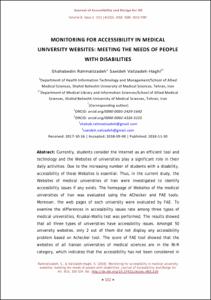Mostra el registre d'ítem simple
Monitoring for accessibility in medical university websites: meeting the needs of people with disabilities
| dc.contributor.author | Rahmatizadeh, Shahabedin |
| dc.contributor.author | Valizadeh-Haghi, Saeideh Valizadeh-Haghi |
| dc.date.accessioned | 2019-05-15T09:46:19Z |
| dc.date.available | 2019-05-15T09:46:19Z |
| dc.date.issued | 2018-11-30 |
| dc.identifier.citation | Rahmatizadeh, S.; Valizadeh-Haghi, S. V. Monitoring for accessibility in medical university websites: meeting the needs of people with disabilities. "Journal of Accessibility and Design for All", 30 Novembre 2018, vol. 8, núm. 2, p. 102-124. |
| dc.identifier.issn | 2013-7087 |
| dc.identifier.uri | http://hdl.handle.net/2117/132990 |
| dc.description.abstract | Currently, students consider the Internet as an efficient tool and technology and the Websites of universities play a significant role in their daily activities. Due to the increasing number of students with a disability, accessibility of these Websites is essential. Thus, in the current study, the Websites of medical universities of Iran were investigated to identify accessibility issues if any exists. The homepage of Websites of the medical universities of Iran was evaluated using the AChecker and FAE tools. Moreover, the web pages of each university were evaluated by FAE. To examine the differences in accessibility issues rate among three types of medical universities, Kruskal–Wallis test was performed. The results showed that all three types of universities have accessibility issues. Amongst 50 university websites, only 2 out of them did not display any accessibility problem based on Achecker tool. The score of FAE tool showed that the websites of all Iranian universities of medical sciences are in the NI-R category, which indicates that the accessibility has not been considered in the design of those websites. Moreover, according to Spearman's correlation test, there was a significant inverse correlation between the score of homepage and the number of known problems (P-value= 0.043). Furthermore, there was a significant correlation between the homepage score and score of other pages (P-value <0.001). The accessibility of medical universities’ Websites is not in an optimal situation, which severely affects the achievement of universities’ visions and missions concerning expanding medical education and improving educational equity. Therefore, it is necessary to make fundamental modifications in this respect. To do so, university, as well as web developers should pay special consideration to accessibility guidelines to make their Websites more accessible. |
| dc.format.extent | 24 p. |
| dc.language.iso | eng |
| dc.publisher | Càtedra d'Accessibilitat (CATAC) |
| dc.rights | Attribution-NonCommercial 4.0 International |
| dc.rights.uri | http://creativecommons.org/licenses/by-nc/4.0/ |
| dc.subject | Àrees temàtiques de la UPC::Informàtica::Sistemes d'informació::Interacció home-màquina |
| dc.subject.lcsh | Accessible Web sites for people with disabilities |
| dc.subject.other | Access to information |
| dc.subject.other | Academic medical centers |
| dc.subject.other | Disabled persons |
| dc.subject.other | User-computer interface |
| dc.subject.other | Internet standards |
| dc.title | Monitoring for accessibility in medical university websites: meeting the needs of people with disabilities |
| dc.type | Article |
| dc.subject.lemac | Accessibilitat web |
| dc.identifier.doi | 10.17411/jacces.v8i2.150 |
| dc.description.peerreviewed | Peer Reviewed |
| dc.rights.access | Open Access |
| local.citation.publicationName | Journal of Accessibility and Design for All |
| local.citation.volume | 8 |
| local.citation.number | 2 |
| local.citation.startingPage | 102 |
| local.citation.endingPage | 124 |


